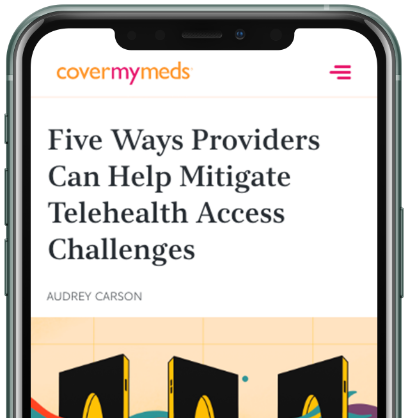ePA Report Findings: Prospective PA Decreases Time to Therapy
When a PA request is submitted electronically, patients can get their medication faster than through the traditional manual PA process, and are more likely to adhere to their therapy. And when that PA request is submitted prospectively, at the point of prescribing, patients access their medications even faster — ~13 days faster, on average.

In a survey conducted for our annual ePA Report, 60% of providers reported their practice completes prior authorization (PA) requests retrospectively, after the pharmacy has notified them that a PA is required. Twenty percent reported they complete requests after a patient has notified them of a PA requirement, while 17% reported they start a PA at the point of prescribing.CoverMyMeds provider survey, November 2019
In the sixth installment of our ePA Report, we expanded our focus beyond provider adoption to examine how prescribing behavior impacts a patient’s ability to access their medication. Here, we offer a few highlights from the report.
Providers don’t always trust their EHR's formulary information
One of the primary reasons providers avoid starting PA requests prospectively is a lack of trust in the plan formulary information supplied in their EHR. In our survey, 60% of providers reported they only sometimes trust the insurance data available in their EHR, while 19% reported they rarely or never trust this information.CoverMyMeds provider survey, November 2019
Real-time benefit check (RTBC) technology is an innovative solution
An RTBC solution — known also as real-time benefit transparency (RTBT) and real-time prescription benefit (RTPB) — can surface prescription benefit details at the point of prescribing. This information includes PA requirements, patient out-of-pocket costs and drug alternatives, enabling providers to make informed medication choices before their patient leaves the office.
Of course, access to this information may not persuade a provider to complete a PA request at the point of prescribing. Instead, a provider may decide to prescribe an alternative medication that doesn’t require PA — or even help their patient find a cash option. Still, greater insight into options at the point of prescribing may result in more consistent, confident PA processes. For more information about prescription decision support solutions like RTBC, check out our 2020 Prescription Decision Support report.
Accelerated turnaround times can result in greater adherence
A faster turnaround time for a PA determination doesn’t just result in a higher dispense rate at the pharmacy. The improved patient perception of access can also translate to a 3% increase in the likelihood that patients will pick up their prescribed medications.CoverMyMeds data on file, 2018
For patients, the PA process can result in delays to therapy — or even abandonment of that therapy altogether.
In a survey conducted by the American Medication Association, 91% of respondents reported PA results in delayed access to necessary care, while 75% reported the PA process has led to patients abandoning treatment altogether.American Medical Association Prior Authorization Survey, 2018
The use of an electronic solution — one that allows providers to complete prospective PA requests in their EHR or in an ePA web portal — has the potential to not only simplify provider and pharmacist workloads, but also increase speed to therapy for millions of patients each day.
The latest healthcare insights, floated right to your inbox.



